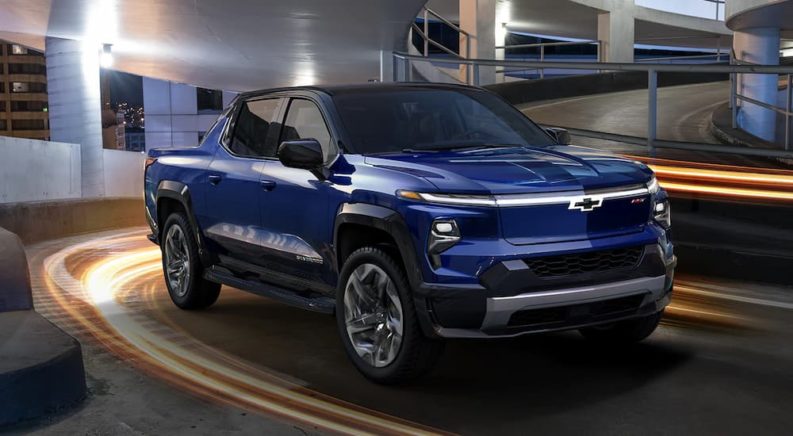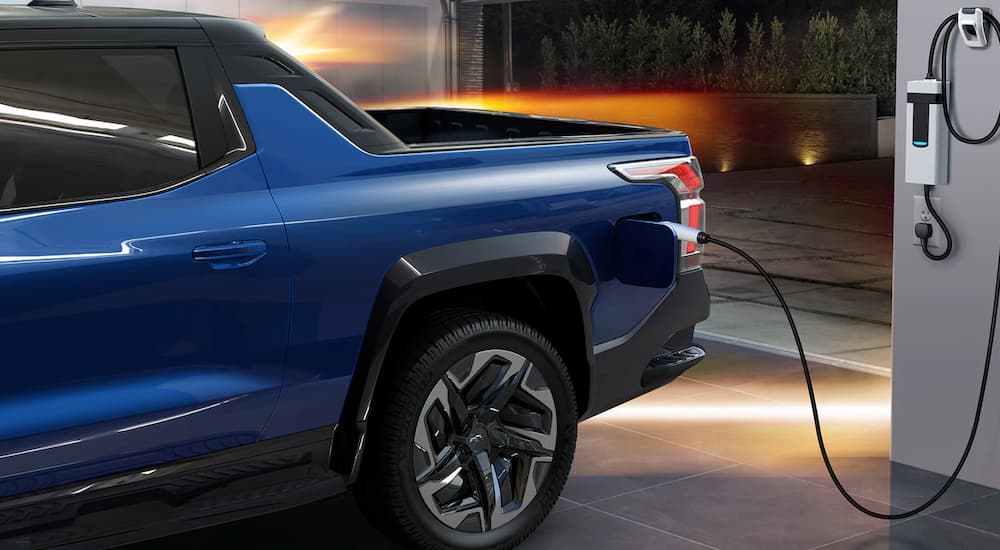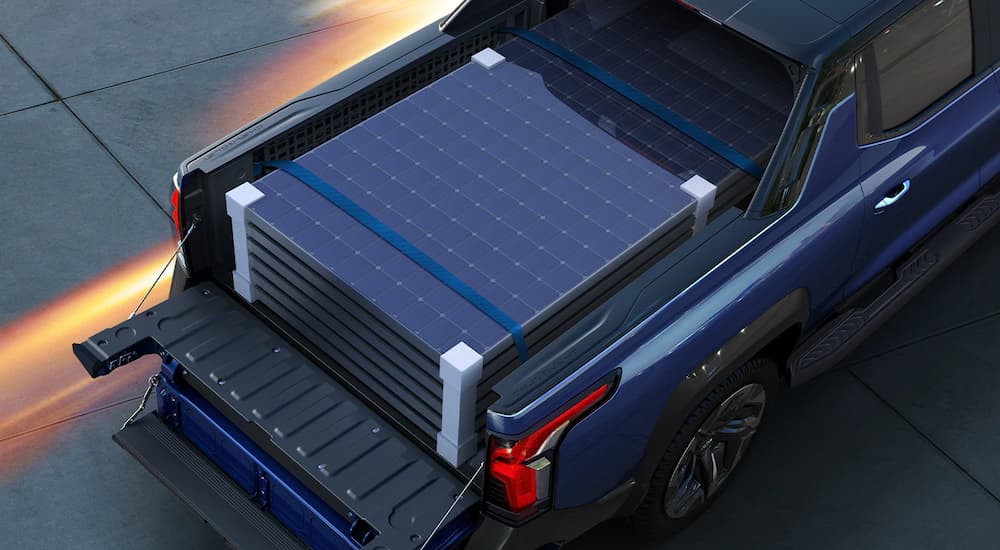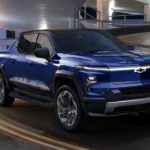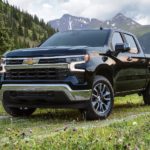It’s finally here! The news we’ve all been waiting for! On January 5th, 2022, in a virtual reveal with the Consumer Electronics Show, General Motors unveiled the all-new 2024 Chevy Avalanche EV pickup truck! The entire industry is abuzz, so I thought I’d give you a summary of what everyone else is saying along with my own take on the truck, and…H-hold on, that’s my phone, I, I need to take this. *muffled* What’s that? They call it a what-now? No, no, that’s the gas truck, have you seen–oh. Oh dear. *clears throat* Excuse me, where was I? Oh yes, the all-new 2024 Chevy Silverado EV pickup truck!
Seriously, They Called It That?
I know! I know. The design is a massive departure from what I expected. First the Mustang Mach-E crossover, now the Silverado EV open-cargo SUV…truck…thing. Just because you call it one doesn’t make it true, and the simple truth is that the 2024 Silverado EV looks exactly how I’d imagine a 2024 Avalanche to be. Shifted proportions that reduce hood length while expanding the cab, a unified cab and bed body, the badass C-pillar sails at the back of the cab–it looks more like the 2009 Avalanche than the 2022 Silverado!
And that’s not a bad thing–I, for one, love it. While the look is an unmistakable departure from the ICE Silverado, it’s a phenomenal balance of unique and futuristic styling with a nostalgic and familiar appeal. Much of the bodywork is functional–a shorter, lower sloped hood improves visibility, air curtain openings on the front fascia reduce drag, and so do the sails themselves. Chief Engineer Nichole Kraatz insists that no inspiration was intentionally drawn from the long-retired Avalanche and that the most Avalanche-esque features (being the sails and mid-gate; more on that later) developed organically in pursuit of achieving their goals for the truck–namely, reaching a 400-mile range and maximizing versatility and flexibility for users.
Where Ford simply adapted the existing F-150 platform for the all-electric Lightning, and Tesla hurtled in from outer space with its concept for the Cybertruck, Chevy chose to go the Rivian route: something developed from the ground-up with a distinctive signature style that’s still grounded in the familiar. The Silverado EV presents the Ultium platform in a more traditional truck form than the outlandish Hummer EV, and its relationship to existing GM EVs like the Bolt EV and Bolt EUV is clear from cues like the front lighting design. Intentional or not, the balance of Avalanche nostalgia, Silverado posture, continuity with the EV lineup, and just a little something extra (the industry-first 24″ factory wheels perhaps?) is breathtaking. Reviewers from small-time Youtubers like right up to industry giants like Jalopnik think it’s fantastic; most just think it’s a crying shame that Chevy didn’t call it an Avalanche. Hey, at least they didn’t name it the “Camaro EV.”
Ultium Inside and Out
Three horizontal bars in the taillights representing the Ultium logo are an exterior clue regarding the underpinnings of this unique pickup. Part of how Chevy could justify a ground-up design for the Silverado EV was the existing Ultium platform, observed today on the Hummer EV. There’s no ladder frame to speak of, so Ultium is not a traditional body-on-frame truck, but it’s not a true unibody either. The platform builds the battery pack into the structure of the vehicle, an as-of-yet unnamed architecture that delivers a low center of gravity, a flat interior floor, and a certain degree of toughness to the truck.
Speaking of the battery–speculations and hesitations are absolutely flying over what powers the Silverado EV. GM’s target range of 400 miles far outstrips the Ford Lightning and has many thinking that the capacity must be as high as 200 kWh, the maximum known capacity for any Ultium battery pack to date. A range of 400 miles is great, but disclaimers abound–towing will reduce range, and Tesla is targeting 500 miles for the currently-theoretical Cybertruck. None of this, however, is really “news,” and for mainstream buyers, that 400-mile figure will give Chevy a 100-mile leg up on Ford.
Another selling point is the impressive 350 kW fast-charge compatibility–far exceeding Lightning’s 150 kW cap. A compatible charging station could replenish 100 miles of range in 10 minutes for the latest EV truck. I am impressed, but it should be remembered that 350 kW chargers are still few and far between. However, third-party charging networks are growing fast, and by the time anybody has their hands on a 2024 Silverado EV, the number of fast chargers could easily increase by an order of magnitude. Skeptics begone, for this is the Ultium electric pickup!
Which EV Pickup Is Worth the Wait?
Is “any of them!” an acceptable answer to the question? I mean, seriously, pickup trucks are so expensive anyways that electrifying them is a small up-front price, and the benefits–instant torque, wild acceleration, unprecedented utility, and an off-roading experience like no other–are plentiful indeed. The thing is, Chevy is a little bit late to the party, even with GM’s aggressive overall electrification goals.
The Rivian R1T is already on the market, and it’s setting an impressive benchmark; the only caveat is that it prices like an upper-trim Silverado EV is expected to, so budget buyers won’t be interested. “Lifestyle” drivers who are unwilling to wait for Tesla will probably prefer the Rivian or Hummer EV super-truck (if they can get their hands on one). On the other hand is the tried-and-true Ford F-150 platform-based Lightning, due to arrive at least a year ahead of the Silverado EV to start capturing a new category of buyers. Regular consumers might want to consider that many of the Ford’s specs lag far behind the Silverado EV’s–except for the Chevy’s payload, which is a paltry 1,300 lbs that even the Ford Maverick can beat–but they’ll be weighing that against the current availability of the Lightning. However, Chevy has a plan.
It’s an interesting rollout strategy–the first Silverado EVs are going to be base WT trim, sold exclusively as fleet models in spring 2023, just before the fully-loaded RST First Edition trim hits the road in the fall. While investors have balked at this unglamorous plan, I see the point–people driving work trucks purchased by their employers don’t have much of a say in what it is, but they’re sure to get familiar with it, and familiarity breeds loyalty in the truck business. Thousands of would-be Ford Lightning buyers might be persuaded to wait it out thanks to their experience with an entry-level Silverado EV WT on the job!
And GM needs a robust plan because it’s investing a lot in the electrification of its lineup. The Orion Plant, which currently builds the Bolt EV and Bolt EUV, will be retooled at the cost of $4 billion to support the Ultium platform and the Silverado EV. The rest of GM’s supply chain is also being upgraded, with the Bedford, Indiana facility currently manufacturing electric drive unit (EDU) castings for the Hummer EV, receiving a further $51 million in investments to add the capacity for the Silverado EV’s EDU. On top of this, GM is putting billions into developing the Ultium platform further.
Speaking of Innovations
Focusing back on the electric truck of the hour, there are a couple of unique innovations applied to the Silverado EV that should interest everybody. Which features deserve such attention? I’m referring, of course, to rear-wheel steer and the multi-flex mid-gate.
Rear-wheel steer has been a GM thing before, featuring prominently in promotions for the first-gen GMC Sierra 1500. Now the feature is back on the Hummer EV, and it’s coming to the Silverado EV too. What this means for drivers of this full-sized pickup truck is that, in combination with its abnormally blunt snout, it will be the easiest truck to handle in any parking lot situation. The added maneuverability makes trailering easier too; at highway speeds, even a tiny bit of rear-wheel steer helps stabilize a trailer (whether using Super Cruise or not). It seems likely that the Hummer EV’s crabwalk feature will be exclusive to the electric super-truck, but at least the rear-wheel steering is available to make the Silverado EV even more accessible to drivers living in cramped quarters.
Then there’s the mid-gate. Oh, the glorious mid-gate. The Chevy Avalanche was not an “alternate Silverado” back in the day–it was essentially a Suburban SUV with an open cargo area, separated from the cab by a 100% removable mid-gate of its own. When folded, the mid-gate increased the cargo area substantially, but that also meant the cabin was open to the elements. The solution? Technology.
And I don’t mean flashy touchscreens; I mean basic 60/40 split mechanics and lockable tonneau covers! GM has established itself as the king of cargo management with features like the side step bumper (which remains present on the Silverado EV) and countless tie-down configurations. Then they came up with the Multi-Flex Tailgate and its six configurations that include a step and a bed extension. Now they’ve added to that with the Multi-Flex Mid-Gate option. Either of the 60/40 split rear seats can be folded down to unlock an additional 3′ of storage length on top of the 5′ 11″ cargo bed (which already beats the Lightning by 6″). With a lockable tonneau cover on the upcoming options list (for 2025, so they say), that gives the Silverado EV a fully enclosed 9’x4′ lockable cargo hold!
Got something tall? The rear glass also folds out of the way to completely open the rear. The mid-gate was a signature of the Avalanche, and now it’s one of the Silverado EV’s most appealing features. But Nichole Kraatz told MotorTrend this was an organic and coincidental development:
“So, if you think about starting with a pass-through and getting a pass-through designed, then you say, ‘well, why not let the whole thing be open?,’ you walk yourself into a midgate. It’s not like we said let’s redo an Avalanche, it was never the conversation.
We don’t want to dictate to the customer how to use the vehicles. We want to give them a vehicle that is capable of just about anything they can imagine. We are designing it for versatility and what the customers can do with it, with awesome styling.”
Let me just leave you with one last figure. When combined with the Multi-Flex Tailgate’s bed extender option, the maximum cargo length that the Silverado EV can handle becomes 10′ 10″. How does that compare with other pickups? Well…the 2019 Chevy Silverado HD trucks offered a segment-leading long bed of 98″, otherwise written as 8′ 2″. Yeah.
That’s an Avalanche of Info!
It’s about time that the electric pickup truck market has fired up, and it’s about time that Chevy announced a Silverado EV. The Bowtie Brand has taken everything that Ford is planning and turned the dial up to 11, setting its sights on Rivian and Tesla’s potential market shares as well. It’s going to take an unfortunately long time to all roll out, but c’est la vie–awesome things are worth waiting for. Even if they aren’t given a fitting name, such as, oh, I don’t know, Avalanche or something badass like that.
…At least Chevy didn’t call it a Camaro EV.

